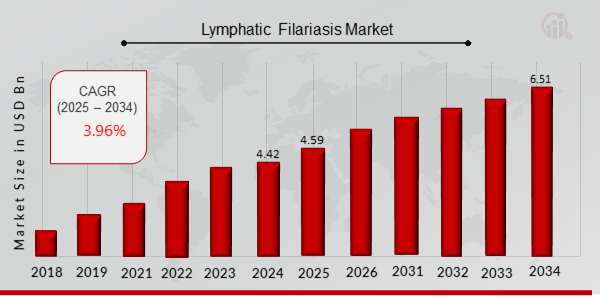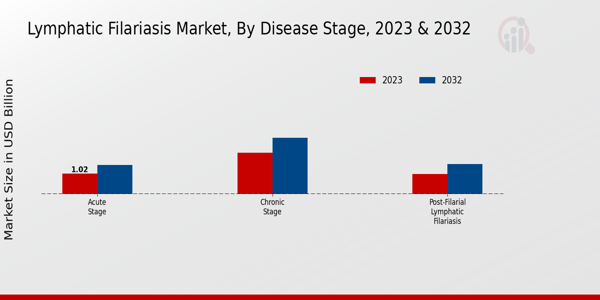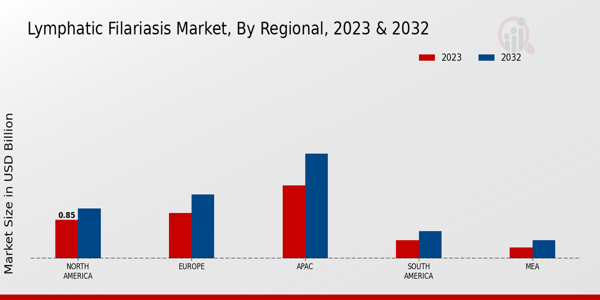Lymphatic Filariasis Market Overview
As per MRFR analysis, the Lymphatic Filariasis Market Size was estimated at 4.42 (USD Billion) in 2024. The Lymphatic Filariasis Market Industry is expected to grow from 4.59 (USD Billion) in 2025 to 6.51 (USD Billion) till 2034, at a CAGR (growth rate) is expected to be around 3.96% during the forecast period (2025 - 2034).
Key Lymphatic Filariasis Market Trends Highlighted
The Lymphatic Filariasis Market is registering remarkable trends owing to a number of factors. With governments and health organizations improving on their prevention strategies, the reason being the growing awareness concerning lymphatic filariasis and its complications. The need for drug development and innovation, more so the need for development of rapid diagnostic tests as well as targeted therapies is also another key driver. As well, the mass drug administration (MDA) strategies being implemented in areas endemic to the disease are aimed at making inroads towards reducing the disease transmission rate and managing the disease effectively. These trends also suggest that there is a coordinated effort to control lymphatic filariasis bottom-line through improved integrated approaches.
There are several areas this market can be expanded or explored. There is the silk road on biotechnology and pharmaceutical research to develop better and efficacious treatment modalities and vaccines. Because of how badly lymphatic filariasis has affected many areas, public-private partnerships can be effective in financing research and recovering execution of major programs in these areas. In addition to this, with the changing scope of investment in health infrastructure in non-endemic regions, barriers to accessing healthcare will reduce allowing for better disease management and control measures. Recently, adjusting strategies of integrated vector management has become a trend.
This includes application of insecticides and use of eco management with an aim of decreasing mosquitoes that transmit lymphatic filariasis. As such, now there is a greater emphasis on community involvement and education as it is important to notify local communities of the disease and the means to prevent it so that measures for control can be effectively implemented. With the global health community finally paying attention to neglected tropical diseases, the market for lymphatic filaria is going to change as it responds to the needs and requirements for health and disease management.

Source: Primary Research, Secondary Research, MRFR Database and Analyst Review
Lymphatic Filariasis Market Drivers
Increased Government Initiatives and Funding for Disease Control
The global struggle against lymphatic filariasis is being bolstered by enhanced government initiatives and funding directed towards disease control. Countries heavily impacted by this parasitic disease have recognized its debilitating effects on health and socioeconomic conditions, prompting a strategic response. These initiatives often encompass comprehensive public health campaigns aimed at raising awareness amongst vulnerable populations, promoting preventive measures such as the distribution of medication, and facilitating educational programs to inform communities about the modes of transmission and risks associated with lymphatic filariasis.In addition, collaborative efforts between governments, non-governmental organizations, and international health bodies are resulting in increased funding for research, diagnostic tools, and treatment options. As a result of these initiatives, the Lymphatic Filariasis Market Industry is expected to see a significant uplift, as robust public health strategies lead to a reduction in prevalence rates and ultimately contribute to market growth as fewer people are afflicted with the disease.
Rising Awareness about Disease Prevention
As awareness about lymphatic filariasis increases, so too does the demand for preventive healthcare solutions. Public health campaigns play a crucial role in educating communities regarding the symptoms, transmission pathways, and available treatments, fostering an environment where disease prevention is prioritized. This surge in awareness directly contributes to the expansion of the Lymphatic Filariasis Market Industry, as more individuals seek information and assistance, leading to a higher adoption rate of preventive measures and treatments.
Advancements in Treatment and Management Options
The Lymphatic Filariasis Market Industry is set to experience notable growth attributed to ongoing advancements in treatment and management options. Innovations in medical research and product development have led to new therapies that improve patient outcomes and enhance the quality of life for those affected by lymphatic filariasis. As new and more effective treatment modalities enter the market, healthcare providers are better equipped to combat this disease, thereby increasing the scope and scale of the market.
Lymphatic Filariasis Market Segment Insights
Lymphatic Filariasis Market Disease Stage Insights
The Lymphatic Filariasis Market has been witnessing steady growth, particularly in the Disease Stage segment, which comprises critical categories essential for understanding disease management and the allocation of resources. As of 2023, the Acute Stage accounted for a valuation of 1.02 USD Billion, indicating its significance in the treatment and early detection of lymphatic filariasis. This portion of the market highlights the initial phase of the disease when intervention can minimize long-term impacts. Transitioning to the Chronic Stage, which holds a substantial valuation of 2.07 USD Billion in 2023, it dominates as the most significant segment, reflecting the long-term consequences and persistent healthcare needs associated with lymphatic filariasis.This longstanding presence not only underscores the necessity for ongoing medical attention but also indicates potential for expanded therapeutic options and patient support systems. Lastly, the Post-Filarial Lymphatic Filariasis stage, valued at 1.0 USD Billion in 2023, represents a crucial phase where individuals may exhibit lasting symptoms despite treatment.
The presence of this segment highlights the ongoing challenges faced by patients even after the disease is treated, emphasizing the need for comprehensive care and rehabilitation strategies.The collectively assessed figures from each category demonstrate the overall dynamics and pressing requirements within the market. Moreover, the growth in these segments can be attributed to increased awareness, advancements in treatment options, and strategic public health initiatives focusing on eradication and management. However, challenges such as access to treatment, healthcare infrastructure, and ongoing research into effective therapies remain significant barriers in this market landscape. Overall, each category Acute Stage, Chronic Stage, and Post-Filarial Lymphatic Filariasis plays a vital role in shaping the Lymphatic Filariasis Market revenue, underscoring varied patient needs and the importance of targeted interventions throughout the disease continuum.The Lymphatic Filariasis Market data continues to reveal trends showing increased funding and resources directed towards prevention and management, fostering opportunities for innovation in the industry. Addressing these segments with focused strategies can effectively enhance patient outcomes and support broader public health goals, necessitating ongoing attention from stakeholders to ensure sustainable growth and improvements in the management of lymphatic filariasis.

Source: Primary Research, Secondary Research, MRFR Database and Analyst Review
Lymphatic Filariasis Market Treatment Type Insights
The Lymphatic Filariasis Market, valued at 4.09 USD Billion in 2023, encompasses a vital Treatment Type segment that includes Medications, Glaucoma Surgery, and Lymphatic Drainage Therapy. The importance of Medications is underscored by their role in managing symptoms and preventing disease progression, which holds a significant share of market revenue due to widespread usage across various demographics. Surgery is critical for addressing severe cases and helps in alleviating complications associated with lymphatic filariasis, making it a necessary option in specific scenarios.Additionally, Lymphatic Drainage Therapy is recognized for its effectiveness in improving lymphatic function and reducing swelling, thus contributing to patient quality of life. The Lymphatic Filariasis Market statistics reflect a steady market growth driven by factors such as increasing awareness, advancements in treatment options, and a growing prevalence of the disease in endemic regions. However, challenges persist, including accessibility to treatment and variation in healthcare infrastructure across different geographies, creating opportunities for innovation and improved healthcare solutions.
Lymphatic Filariasis Market Distribution Channel Insights
The Lymphatic Filariasis Market, focusing on the Distribution Channel segment, was valued at 4.09 billion USD in 2023 and is expected to show steady growth over the coming years. The distribution channels primarily include Hospitals, Clinics, Pharmacies, and Online Pharmacies, each playing a crucial role in the market dynamics.
Hospitals remain a key access point for patients due to their comprehensive care and specialized services. Clinics are significant as they provide localized care, increasing accessibility for patients in remote areas.Pharmacies serve as the frontline for patients seeking over-the-counter treatments and prescription medications, making them essential in facilitating prompt medical response and access. Online Pharmacies have gained traction, especially post-pandemic, offering convenience and wider reach, which is increasingly important in today's digital age. With a growing awareness of lymphatic filariasis and improved healthcare infrastructure, the market is expected to see a rise in demand through these distribution channels.
Each channel contributes uniquely to the Lymphatic Filariasis Market revenue, influenced by trends such as telemedicine and increasing patient education regarding preventive measures.The market growth is supported by an increase in healthcare spending and government initiatives targeting neglected tropical diseases, presenting significant opportunities for stakeholders.
Lymphatic Filariasis Market End User Insights
The Lymphatic Filariasis Market has shown substantial growth, driven by several factors associated with its key End User categories. As of 2023, the market is valued at 4.09 USD Billion, reflecting a significant demand across various sectors. Within the End User segment, hospitals play a crucial role, serving as primary facilities for diagnosis and treatment, which helps in addressing the health impacts of lymphatic filariasis.
Research laboratories are also vital, enhancing the understanding of the disease and facilitating the development of more effective treatments.Furthermore, Home Care Settings have gained traction, providing patients with necessary support and care in a more personal environment. Overall, the Lymphatic Filariasis Market data demonstrates the importance of these End User segments in delivering accessible healthcare solutions and fostering research, which is crucial for combating the disease. The market's growth potential in these areas highlights opportunities for enhanced patient care, innovative treatment modalities, and continued research advancement in the coming years.
Lymphatic Filariasis Market Regional Insights
The Lymphatic Filariasis Market is projected to achieve significant growth across various regions. In 2023, the North America segment is valued at 0.85 USD Billion, while Europe follows closely with a valuation of 1.0 USD Billion. The APAC region holds the largest share at 1.6 USD Billion, highlighting its major role in the market, driven by high prevalence in specific countries and effective disease management programs.
South America is evaluated at 0.4 USD Billion, representing a growing market despite its smaller size, whereas MEA stands at 0.24 USD Billion, showing potential for future development. By 2032, North America is set to increase to 1.1 USD Billion, and Europe is expected to reach 1.4 USD Billion. The APAC region's anticipated rise to 2.3 USD Billion further emphasizes its dominance in the Lymphatic Filariasis Market revenue.
This variability in market values underscores the importance of tailored strategies for disease eradication and management across different regions. Factors such as rising awareness, increased funding for neglected tropical diseases, and government initiatives are significant growth drivers. However, challenges remain, including socio-economic barriers and inadequate healthcare infrastructure in certain regions, providing potential opportunities for market players to expand and innovate in the industry.

Source: Primary Research, Secondary Research, MRFR Database and Analyst Review
Lymphatic Filariasis Market Key Players and Competitive Insights
The Lymphatic Filariasis Market has seen notable competition driven by the increasing prevalence of lymphatic filariasis across various regions, particularly in tropical and subtropical climates. This disease, caused by parasitic worms transmitted through mosquito bites, has posed significant challenges to public health in affected areas.
As a result, the market is characterized by a race among pharmaceutical companies to develop effective treatments and vaccines, alongside ongoing efforts to engage in mass drug administration programs to eliminate the disease. The competitive landscape is shaped by factors including innovations in drug formulations, strategic partnerships, advancements in distribution networks, and comprehensive approaches to disease management and eradication.
Companies are also focusing on improving access to essential medicines and enhancing awareness and education about lymphatic filariasis, resulting in a dynamic and rapidly evolving market environment.Merck and Co hold a strong position within the Lymphatic Filariasis Market due to its commitment to researching and developing effective treatments and its strategic involvement in public health initiatives aimed at disease eradication. The company has made significant strides in producing antifilarial medications that effectively target the parasites responsible for lymphatic filariasis. In addition to its research capabilities, Merck and Co has established partnerships with global health organizations, allowing it to bolster its presence in endemic regions and enhance the accessibility of its treatments.
The strength of Merck and Co lies not only in its pharmaceutical offerings but also in its dedication to community health initiatives that align with its overall mission to improve health outcomes and contribute to the elimination of neglected tropical diseases. This comprehensive approach has positioned Merck and Co as a key player in the market, garnering trust and support from various stakeholders involved in combating lymphatic filariasis.Pfizer is also a prominent competitor in the Lymphatic Filariasis Market, recognized for its robust portfolio of therapeutic solutions and commitment to combating infectious diseases.
Pfizer's established presence can be attributed to its investment in research and development, which has facilitated the creation of effective treatment options that contribute to the management and potential eradication of lymphatic filariasis. The company's collaboration with public health authorities and non-governmental organizations strengthens its role in global health initiatives, ensuring that its medications reach the populations that need them most. Pfizer is skilled at leveraging its extensive distribution and marketing capabilities to ensure that vital drugs are readily available in endemic regions.
This strategic positioning, along with its innovative therapeutic advancements, underscores Pfizer's commitment to addressing lymphatic filariasis and enhancing health outcomes in targeted areas, thus contributing to its competitive edge in this market.
Key Companies in the Lymphatic Filariasis Market Include
- Merck and Co
- Pfizer
- Takeda Pharmaceutical
- Amgen
- Mylan
- AbbVie
- Roche
- GlaxoSmithKline
- Johnson and Johnson
- AstraZeneca
- Bayer
- Novartis
- BristolMyers Squibb
- Gilead Sciences
- Sanofi
Lymphatic Filariasis Market Industry Developments
Recent developments in the Lymphatic Filariasis Market have seen increased activity among key players like Merck & Co., Pfizer, and Takeda Pharmaceutical, focusing on innovative treatment solutions. Significant investment in research and development aimed at novel therapeutic approaches is underway, highlighting a growing interest in eradicating lymphatic filariasis, which affects millions globally.
Additionally, companies such as Amgen, Mylan, AbbVie, Roche, and GlaxoSmithKline are involved in collaborative efforts to enhance drug accessibility and awareness within endemic regions. The market has also experienced notable growth in valuation, driven by heightened governmental and non-governmental organization initiatives promoting better healthcare infrastructure and disease management strategies.
Though mergers and acquisitions have been relatively limited, industry attention remains on strategic partnerships and collaborations among large firms such as Johnson & Johnson and AstraZeneca to bolster their portfolios in infectious disease management. Companies like Bayer and Novartis are actively seeking to expand their global outreach by investing in anti-filarial drug development. Overall, these developments reflect a concerted effort to combat lymphatic filariasis effectively and address the healthcare challenges posed by this disease.
Lymphatic Filariasis Market Segmentation Insights
Lymphatic Filariasis Market Disease Stage Outlook
- Acute Stage
- Chronic Stage
- Post-Filarial Lymphatic Filariasis
Lymphatic Filariasis Market Treatment Type Outlook
- Medications
- Surgery
- Lymphatic Drainage Therapy
Lymphatic Filariasis Market Distribution Channel Outlook
- Hospitals
- Clinics
- Pharmacies
- Online Pharmacies
Lymphatic Filariasis Market End User Outlook
- Hospitals
- Research Laboratories
- Home Care Settings
Lymphatic Filariasis Market Regional Outlook
- North America
- Europe
- South America
- Asia Pacific
- Middle East and Africa
| Report Attribute/Metric |
Details |
|
Market Size 2024
|
4.42 (USD Billion)
|
|
Market Size 2025
|
4.59 (USD Billion)
|
|
Market Size 2034
|
6.51 (USD Billion)
|
|
Compound Annual Growth Rate (CAGR)
|
3.96 % (2025 - 2034)
|
|
Report Coverage
|
Revenue Forecast, Competitive Landscape, Growth Factors, and Trends
|
|
Base Year
|
2024
|
|
Market Forecast Period
|
2025 - 2034
|
|
Historical Data
|
2020 - 2024
|
| Market Forecast Units |
USD Billion |
| Key Companies Profiled |
Merck and Co, Pfizer, Takeda Pharmaceutical, Amgen, Mylan, AbbVie, Roche, GlaxoSmithKline, Johnson and Johnson, AstraZeneca, Bayer, Novartis, BristolMyers Squibb, Gilead Sciences, Sanofi |
| Segments Covered |
Disease Stage, Treatment Type, Distribution Channel, End User, Regional |
| Key Market Opportunities |
Rising awareness and education programs, Innovative treatment and drug development, Improved diagnostic technologies, Growth in government funding, Collaborative global partnerships and initiatives |
| Key Market Dynamics |
Rising prevalence of lymphatic filariasis, Increased funding for elimination programs, Advancements in diagnostic tools, Growing public awareness campaigns, Strengthening healthcare infrastructure |
| Countries Covered |
North America, Europe, APAC, South America, MEA |
Frequently Asked Questions (FAQ) :
The Lymphatic Filariasis Market is expected to be valued at 5.8 USD Billion by 2034.
The expected CAGR for the Lymphatic Filariasis Market from 2025 to 2034 is 3.96%.
The Chronic Stage held the highest market value in 2023 at 2.07 USD Billion.
The market size for the Acute Stage of Lymphatic Filariasis is expected to reach 1.46 USD Billion by 2034.
The APAC region accounted for the largest share of the Lymphatic Filariasis Market in 2023 with 1.6 USD Billion.
The projected market value for North America by 2034 is 1.1 USD Billion.
Major players in the Lymphatic Filariasis Market include Merck, Pfizer, and Roche among others.
The Post-Filarial Lymphatic Filariasis market is expected to reach 1.51 USD Billion by 2034.
The expected market size for the South America region in 2034 is 0.6 USD Billion.
The market for the Chronic Stage is projected to grow to 2.83 USD Billion by 2034.

















